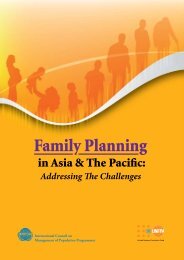Inter-lInkages between PoPulatIon DynamIcs anD DeveloPment In ...
Inter-lInkages between PoPulatIon DynamIcs anD DeveloPment In ...
Inter-lInkages between PoPulatIon DynamIcs anD DeveloPment In ...
You also want an ePaper? Increase the reach of your titles
YUMPU automatically turns print PDFs into web optimized ePapers that Google loves.
structure has contributed to both declines in birth and death rates. Thus, the net effect of increasedcontraception on population growth rate has been partially offset by these changes. The expected decline infertility rate would mean a decline of population below age 15 years to around 23% and increase in theproportion of the elderly (age 60+ years) to around 12.4% by 2025.A cause of concern is the deteriorating gender balance. The sex ratio has turned unfavourable towards youngfemales as well as among adults, but favourable towards elderly females. This is due to the adverse sex ratioat birth (SRB) and improvement in female mortality.<strong>In</strong>dia’s population is distributed across 35 states and its size and growth rate vary widely. The populationgrowth rate among four large north <strong>In</strong>dian states - Bihar, Madhya Pradesh, Rajasthan, Uttar Pradesh - is high.These states, along with some smaller states, account for 39% of the population, but are expected to contribute48% of the growth in the population <strong>between</strong> 2001 and 2026.As there is high variation among states in terms of population growth, so also is there a high regional and socialdisparity among development in states. For instance, against the national GDP growth rate of 7.7% during theperiod 2002/06, the growth in state domestic products in large North <strong>In</strong>dian states is as follows: 4.7% in Bihar,4.3% in Madhya Pradesh, 5% in Rajasthan and 4.6% in Uttar Pradesh. These regional and social imbalancesare a great cause of concern. Therefore, the Eleventh Five-Year Plan has set a vision of inclusive growth.Selected key socio-economic indicators (%)Literacy rate, male, 2001 75.3Literacy rate, female, 2001 53.7Total literacy rate, 2001 64.8Unemployment rate, 2004-2005 8.3Population living below poverty line, rural, 2004-2005 28.3Population living below poverty line, urban, 2004-2005 25.7Population living below poverty line, total, 2004-2005 27.5Children 0-3 years of age group malnourished, 2005-2006 46.0Relevant Policies related to <strong><strong>In</strong>ter</strong>-linkages <strong>between</strong> Population Dynamics and DevelopmentA range of policies, consisting of core national policies and sector-specific strategies, were formulated by<strong>In</strong>dia to guide the management of national development. The policies are reflected in its Eleventh Five-YearPlan. The key policies and sector-specific strategies are as follows:National Population Policy 2000<strong>In</strong>dia formulated a National Population Policy (NPP) in year 2000 superseding the earlier policy of 1976. Itrecognised the inter-linkages <strong>between</strong> population dynamics and development.The immediate objective of the NPP 2000 is to address the unmet need for contraception, health careinfrastructure, and health personnel, and to provide integrated service delivery for basic reproductive andchild health (RCH) care. It sought to bring the TFR to replacement levels by 2010 and achieve a stablepopulation by 2045.<strong>In</strong> pursuance of these goals, it set several objectives in terms of reduction in IMR and MMR, delayed age ofmarriage for girls and increase in institutional deliveries. It also set several facilitative objectives, includingaddressing the unmet needs for basic RCH services, supplies and infrastructure; free and compulsory educationof girls up to age 14 years; and universal access to counselling and services for fertility regulation and contraception.9














